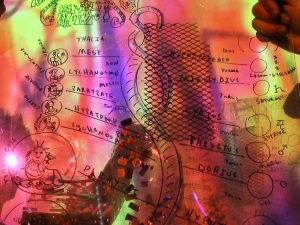
The image is the class video intervention object my Advanced class created last spring—it’s an image of Music of the Spheres by Francinus Gafurius, published in Florence in 1496. The Eight Muses (Clio, Caliope, Terpsicore, Melpomene, Eratho, Euterpe, Polihymnia, and Uania—such great names of nobody’s daughters these days) are mapped to the heavens (the five known planets, Moon, Sun, and stars) and the Eight Musical Modes (Dorian, Phrygian, Lydian, Mixolydian, and their hypo-counterparts). A Cerberus-headed serpent at the bottom of the chart invokes the Four Elements, and so forth. An amazing graphic, and I refer to it in my little book (forthcoming post) as a 15th century interface design. Anyway, we rendered the image in our class in plexiglass, magic marker, mylar tape, shiny broken pieces of CDs, shards of wire mesh, and the broken electronics from ancient synthesizers.
But, one needs some suitable music to contemplate Music of the Spheres, so let’s go with the 40-part motet Spem in alium (probably between 1572-1596) by Thomas Tallis. The above linked recording, long out of print, features the Clerkes of Oxenford, conducted by David Wulstan. If that’s not celestial, shoot me. And look at the score sometime, to see how a composer manages 40 individual vocal parts.
(I can’t top that. Maybe the closest I ever came to celestiality is the moment of Vin’s Suicide from the BLUE HAMMER soundtrack. Find a copy of the meme gig 2 music, and Vin enters other dimensions at around 17:44.)